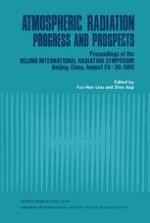1987 | OriginalPaper | Buchkapitel
Remote Sensing of Precipitable Water Vapor and Cloud Liquid Water Content Over the Ocean by Ground-Based Dual-Wavelength Radiometer
verfasst von : Wei Chong, Lin Hai, Zou Shouxiang, Xuan Yuejian
Erschienen in: Atmospheric Radiation
Verlag: American Meteorological Society
Enthalten in: Professional Book Archive
Aktivieren Sie unsere intelligente Suche, um passende Fachinhalte oder Patente zu finden.
Wählen Sie Textabschnitte aus um mit Künstlicher Intelligenz passenden Patente zu finden. powered by
Markieren Sie Textabschnitte, um KI-gestützt weitere passende Inhalte zu finden. powered by
The microwave radiation transfer in a cloudy atmosphere at wavelength 1.35cm and 0.85cm was calculated by using conventional radiosonde data at Guangzhou, China (23°N, 113.3°E) and the Yap Island, a trust territory of the U. S. A. (9.6°N, 138°E). Regressive relationships were established among microwave brightness temperature (Tb λ ), microwave attenuation (τ λ ), atmospheric precipitable water vapor (Q), and liquid water content of clouds (L). A physical-statistical method is modified to retrieve the Q and L from Tb λ and τ λ based on these relationships.From December 1985 to January 1986, we jointed the “Survey over Western Pacific Tropical Area,” a part of a research project entitled “Ocean-Atmosphere Interaction over Western Pacific Area and Its Relation to Interannual Variation of Eastern Asia Climate” sponsored by the Chinese Academy of Sciences. The unique data of Q and L over tropical and subtropical areas were obtained by measurements of the dual-wavelength radiometers. Some statistical results and cases are given.In addition, a model calculation indicates the possibility of determining the precipitable water vapor in a clear atmosphere by using 0.85 cm radiometer only. The measurements over the ocean confirm the theoretical estimation. Based on this, a criterion of identifying cloudy or clear days by using dual-wavelength radiometers is suggested.
